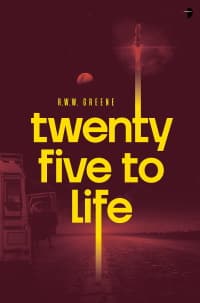
Twenty-Five to Life by R.W.W. Greene
(Angry Robot, 2021)
Reviewed by Phil Nicholls
The background to Twenty-Five to Life is standard cyberpunk fare: the environment is trashed, sea levels have risen and the weather fluctuates wildly. The US Government has traded the bulk of the Midwest with China to cancel a balance of trade deficit, Texas declared independence from the Union and large parts of the South are dedicated refugee camps.
Greene expands this typical setting with half-hearted attempts to colonise the moon and Mars, plus a generation ship sent to Proxima Centauri as a last-ditch attempt to save humanity. Furthermore, the US has passed the Thirtieth Amendment, removing all rights from anyone under the age of 25.
Another twist on the standard cyberpunk tropes is the online ThirdEye software. This version of the internet is a drug for the masses, not a cool arena for digital samurai to duel over data. Greene’s citizens are expected to live in small concrete cubes and spend their lives enjoying the digital thrills of ThirdEye. Yet the internet is not all bad. This same connectedness is presented as benign with the volksnet, the information-sharing network favoured by the roaming nomads.
Surprisingly, Twenty-Five to Life uses all of the above as merely background detail as Greene focuses on telling a different story entirely, one with a much narrower focus. The book begins with a familiar account of teen rebellion, heightened by the restrictive Thirtieth Amendment. Julie runs away from her controlling mother but is quickly recaptured by the police. After a short, brutal prison sequence Julie escapes again and meets Ranger.
Here the story pivots to focus on America’s nomad community. Despite the cyberpunk trappings, this is less Mad Max and more celebration of the American highway in the tradition of On the Road and Route 66. Greene even includes a nod to the film Nomads with the in-setting film Just Plain Volks. Once Julie is riding with Ranger, the book shows its true themes of personal identity and found family.
The core of Twenty-five to Life is a picaresque travelogue through the abandoned heartland of America. We meet a kaleidoscope of travellers and caravans, usually in abandoned shopping malls or ravaged National Parks. Life on the road is not easy and Julie is faced with several grim encounters. Yet the warmth of her relationship with Ranger and the growth of her character pulls the reader along. This is one of those novels where the plot has a tight focus and we are happy to just spend time with Julie and Ranger.
Greene’s setting does contain more epic stories, such as a potentially doomed colony on Mars, the seeding ship sent to Proxima Centauri and an earth-bound plan to save humanity. Any one of these would make a fine story, but instead Greene tells this more personal tale. Some novels fail because the author was overly ambitious. By staying focused on one person’s experience of his world, Greene has written a charming story which connects with the reader.
Sadly, the ending felt rushed. Where the early part of Julie’s travels is related in great detail, the last stage is skipped over. Her personal development is satisfying, but there is a geographical jump which seems hurried. Endings are always difficult to review, as I do not want to spoil anything. The main body of the book retelling Julie as a nomad is a pivot from the early chapters about her rebellion against her mother. Thus, there is a structural balance to the last few chapters in turn also pivoting away from the detailed travelogue of the central section.
Despite these shortcomings of the ending, Twenty-five to Life is a clever cyberpunk novel focusing on nomadic travellers. Julie is a wonderful character and I loved travelling the highways and byways of post-apocalypse America with her.
Review from BSFA Review 16 - Download your copy here.
